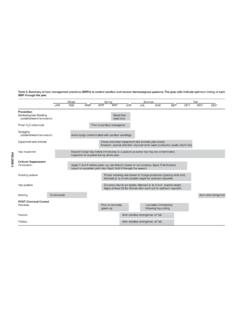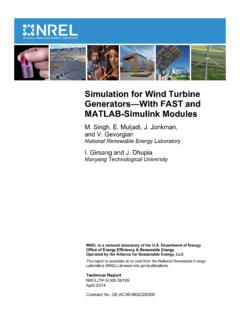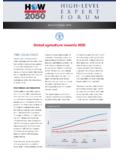Transcription of Nutrient Requirements of Beef Cattle - OSU Fact Sheets
1 Nutrient Requirements of beef CattleE-974 Department of Animal Science Oklahoma Cooperative Extension Service Division of Agricultural Sciences and Natural Resources Oklahoma State UniversityObjectives Discuss the Nutrient Requirements of beef Cattle . Provide tables that list the Nutrient Requirements of beef Cattle . Explain how a balanced and cost effective nutrition program is essential to the success of any beef Cattle operation. Expensive grasslands demand efficient utilization of forages. Supplemental feeding and complete feeding programs must be designed to meet the Nutrient needs of beef Cattle and at the same time make the most of the available feed resources.
2 Nutri-ent Requirements of Cattle change with age, stage of production, sex, breed, environmental conditions and basal diet quality and amount. Therefore, gaining knowledge of Nutrient Requirements and the factors influencing these Requirements is a necessary first step to designing a nutrition program that is both efficient and cost effective. This section will discuss the protein, energy , min-eral and vitamin Requirements of beef Cattle . In addition, tables of Nutrient Requirements are Matter Intake There really is no requirement for feed intake, although an estimate of how much forage and feed an animal will consume is essential when evaluating rations, supplements or predicting animal performance.
3 Dry matter (DM) intake is influenced by a number of different factors. A few of the more important variables include animal weight, condition, stage of production, level of milk production, forage quality, amount and type of supplement or feed provided, as well as environmental conditions. Cattle have a daily requirement for a certain quantity of specific nutrients such as protein, calcium and vitamin A. The necessary concentration of these nutrients in the diet (to meet the animal s requirement) is then determined by the amount of feed consumed. For example, steer calves gaining 2 pounds per day may require pounds of protein per day.
4 If they consume 15 pounds of DM daily, the protein requirement could be expressed as percent of DM intake. On the other hand, if they are limit fed to consume only 10 pounds of DM daily, the protein requirement for 2 pounds of gain could be expressed as 16 percent of DM intake. Intake in forage-fed Cattle is generally limited by the forage capacity of the digestive tract. Values presented in Table 1 provide rule-of-thumb guidelines for variation in DM intake based on dif-ferences in forage quality and stage of production for beef cows. Forage digestibility values rarely exceed 70 percent to 74 percent of DM.
5 Calves and yearlings frequently are fed higher quantities of concentrate feeds to improve weight gain and feed conversion above what can be achieved with forage alone. When diet digest-ibility approaches 70 percent, feed intake is no longer regulated or limited by the capacity of the digestive tract. Rather, with diets high in digestible energy , physiological mechanisms are turned on to limit intake (Figure 1). This response can be thought of as a built-in safety mechanism so Cattle are less likely to consume too much of a highly digestible diet, causing digestive upset, bloat and founder.
6 Forage intake is highly correlated with forage quality as shown in Figure 2 and in Table 1. The more rapid rate of digestion and passage of higher quality forage results in considerably higher dry matter intake compared to forage lower in digestibility. Cattle with greater mature body weight and frame size con-sume more forage compared to smaller frame Cattle . Lactating cows consume considerably more of the same quality forage compared to gestating cows (Figure 3). Additionally, fleshy Cattle 1 Figure . The relationship of diet digestibility to dry matter intake in growing calves.
7 Source: NRC. 54 59 64 69 75 83 TDN, % of Diet Dry Intake, % of Body Weight300 lbs600 lbsFigure . The relationship of forage digestibility to dry matter intake in beef cows. Source: NRC. 42 47 52 57 62 67 TDN, % of Diet Dry Intake, % of Body WeightFigure Dry matter intake, expressed as percent of body weight, of beef cows consuming low quality forage during three different stages of production. Source: Johnson et al. Late Early Late Gestation Lactation Intake, % of Body WeightDavid LalmanProfessor, beef CattleChris RichardsAssociate Professor, beef Cattleconsume 3 to 10 percent less feed or forage compared to Cattle that are in average to thin condition.
8 Cold stress increases dry matter intake, while heat stress reduces dry matter intake. With this many factors influencing this trait, dry matter intake is very difficult to accurately predict. Estimates of dry matter intake presented in the Nutrient requirement tables are determined using published prediction equations. These equations take into account the effects of the animal s weight, level of milk production for lactating cows, en-ergy content of the diet, stage of production and body condition in the case of the pregnant replacement heifers. It is important to note all of these equations assume adequate protein is supplied in the diet to maximize ruminal fermentation.
9 In other words, if the diet is deficient in protein, these dry matter intake values will overestimate the amount the Cattle will actually Proteins are large chemical units made up of hundreds of amino acids. Amino acids, in turn, are organic or carbon-containing compounds that also contain nitrogen, oxygen and sometimes sulfur. Animals consume proteins in their diets, then utilize the amino acids for synthesis of muscles, blood proteins and other body components. In swine, poultry and other nonruminants, the amino acids must be supplied in definite proportions in the diet.
10 However, in ruminants, microorganisms (bacteria and protozoa) break down most dietary proteins and incorporate the nitrogen and amino acids into their own body tissue. The microorganisms are digested in the small intestine of the ruminant animal. The bacteria themselves have a protein requirement and must have adequate protein to do their job of digesting roughages to end products that can be utilized by the cow. Because of the ruminal breakdown of dietary proteins and because the amino acid makeup of microorganisms is adequate for most classes of beef Cattle , feed and forage amino acid composition is generally not critical compared to nonruminant diets.







